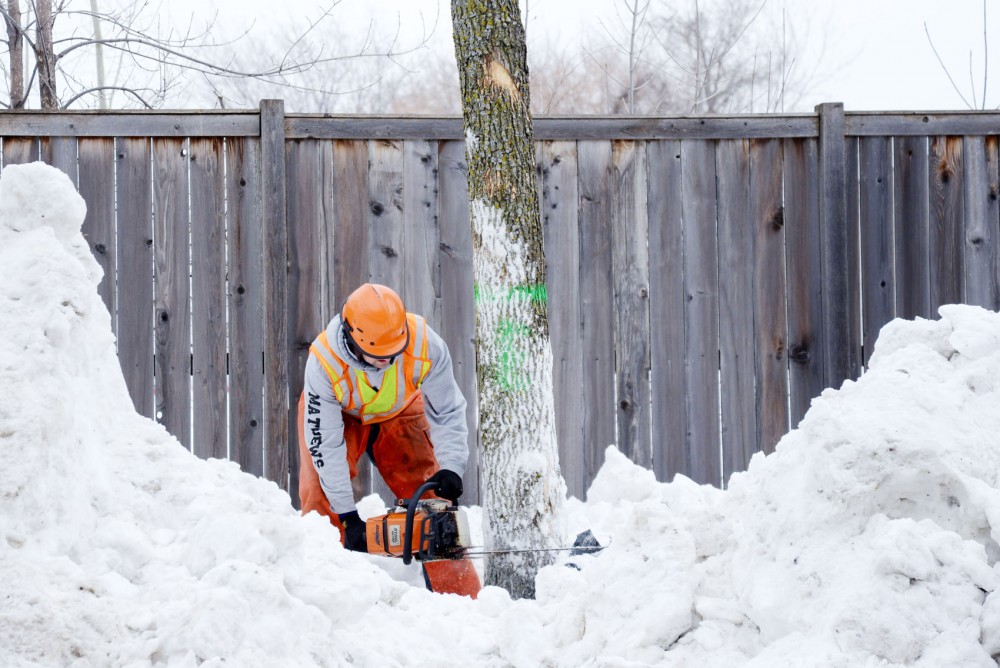Southeast Como residents may have a little less shade this spring.
Last week, city workers removed about 66 ash trees from the neighborhood that were infected by the emerald ash borer, a parasitic beetle that has killed hundreds of millions of ash trees in the U.S. since its discovery in Michigan in 2002.
Workers also removed about 17 ash trees from the Marcy-Holmes neighborhood and about 22 in St. Anthony West, leaving some blocks without any trees lining their streets.
To prevent cutting down mass clusters of trees in the future, the city is implementing an approximately $9 million plan to phase out 40,000 ash trees over the next eight years. The program to replace the ash trees with several other species will start this spring, and the city will cut down as many as 5,000 ash trees per year starting this summer.
“Those are going to be trees that are not known to be infested,” said Ralph Sievert, forestry director for the Minneapolis Park and Recreation Board. “They’re just trees that are ash, and we’re going to work on phasing ash out of the system.”
The park board estimates that the city has 210,000 ash trees, and removing them could cost up to $152 million.
Keeping a more diverse tree base will help prevent blocks from losing all their trees in the future, he said.
The city faced a similar problem in the 1970s with Dutch elm disease, Sievert said. At that time, elms made up more than 90 percent of all trees in the city.
Today, about 20 percent of city trees are ash trees — but diversification is still an issue.
Perry Dean has lived in Como for 37 years, and he said he remembers when the city had to cut down most of the elm trees because of Dutch elm disease.
“You would have thought they learned a lesson in 1977 with planting a monoculture of trees,” he said. “They should have mixed them up back then — then we wouldn’t be facing this.”
Sievert said the city did mix the trees up after dealing with Dutch elm disease. But that diversification was block-by-block, he said, so there are still entire stretches populated by a single species.
The city plans to plant at least a few different species on each block to create a more stable ecosystem, Sievert said.
“It’ll be a real diverse mix,” he said. “Things like hackberries and honey locusts and lindens.”
Les Potts, University of Minnesota grounds superintendent, oversees treatment of ash trees on campus. Potts said the University had to remove 650 trees when the infection first emerged in area in 2009 but hasn’t had to remove any ash trees since 2011. Still, he said, they occasionally test ash trees for infection and chemically treat any that they believe are in danger.
While the infestation has devastated the state’s ash population, Minnesota is faring better than many other infected states, said Minnesota Department of Agriculture entomologist Mark Abrahamson. This is partially because the state discovered the infestation relatively early on and was able to learn from how other infected states handled it, he said.
The biggest challenge with fighting the emerald ash borer is the beetle’s ability to reproduce in large numbers, Abrahamson said, and slowing that down often has to occur at the local level.
University Extension entomologist Jeffrey Hahn said residents can play an important role in slowing down the spread of the emerald ash borer in their neighborhoods by recognizing signs of infection and immediately reporting it to city officials. Signs include S-shaped rivets under the bark that form when the beetle burrows inside.
Hahn said it’s also important to be careful not to spread the beetle when transporting firewood.
“We have close to a billion ash trees in Minnesota, so we have a lot to potentially lose,” he said. “It does make a difference if we can slow it down.”

















